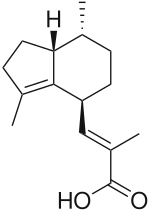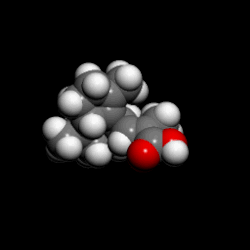Valerenic acid
Valerenic acid
Jump to navigation
Jump to search
 | |
 | |
| Names | |
|---|---|
IUPAC name (2E)-3-[(4S,7R,7aR)-3,7-dimethyl-2,4,5,6,7,7a-hexahydro-1H-inden-4-yl]-2-methylacrylic acid | |
| Identifiers | |
CAS Number |
|
3D model (JSmol) |
|
ChEBI |
|
ChemSpider |
|
ECHA InfoCard | 100.112.154 |
PubChem CID |
|
UNII |
|
InChI
| |
SMILES
| |
| Properties | |
Chemical formula | C15H22O2 |
Molar mass | 234.334 |
Except where otherwise noted, data are given for materials in their standard state (at 25 °C [77 °F], 100 kPa). | |
Infobox references | |
Valerenic acid is a sesquiterpenoid constituent of the essential oil of the Valerian plant.[citation needed]
Valerian is used as a herbal sedative which may be helpful in the treatment of insomnia. It is likely that several components of the plant contribute to the effect. Valerenic acid is thought to be at least partly responsible for the sedative effects.[1]
Valerenic acid acts as a subtype-selective GABAA receptor positive allosteric modulator via a binding site in the transmembrane domain at the β+α− interface.[2] At receptors expressed in Xenopus oocytes (frog eggs) it was shown that only assemblies incorporating β2 or β3 subunits were stimulated by valerenic acid. Modulation of ion channel action was not significantly dependent on incorporation of α1, α2, α3 or α5 subunits.[3]
At the 5-HT5A receptor valerenic acid acts as a partial agonist. This serotonin receptor subtype is distributed in the suprachiasmatic nucleus, a tiny brain region implicated in the sleep-wake cycle.[4]
A study in 2006 found valerian extract as well as valerenic acid to inhibit NF-κB, a protein complex that controls the transcription of DNA, in HeLa (cultured human cancer) cells. This was measured with the IL-6 / Luc (Interleukin-6 luciferase) assay as a measurement tool. The study mentioned that such inhibition may be connected to the reported anti-inflammatory action of the valerian plant.[5]
References[edit]
^
Yuan, C. S.; Mehendale, S.; Xiao, Y.; Aung, H. H.; Xie, J. T.; Ang-Lee, M. K. (2004). "The gamma-aminobutyric acidergic effects of valerian and valerenic acid on rat brainstem neuronal activity" (pdf). Anesthesia and Analgesia. 98 (2): 353–358. doi:10.1213/01.ANE.0000096189.70405.A5. PMID 14742369..mw-parser-output cite.citation{font-style:inherit}.mw-parser-output q{quotes:"""""""'""'"}.mw-parser-output code.cs1-code{color:inherit;background:inherit;border:inherit;padding:inherit}.mw-parser-output .cs1-lock-free a{background:url("//upload.wikimedia.org/wikipedia/commons/thumb/6/65/Lock-green.svg/9px-Lock-green.svg.png")no-repeat;background-position:right .1em center}.mw-parser-output .cs1-lock-limited a,.mw-parser-output .cs1-lock-registration a{background:url("//upload.wikimedia.org/wikipedia/commons/thumb/d/d6/Lock-gray-alt-2.svg/9px-Lock-gray-alt-2.svg.png")no-repeat;background-position:right .1em center}.mw-parser-output .cs1-lock-subscription a{background:url("//upload.wikimedia.org/wikipedia/commons/thumb/a/aa/Lock-red-alt-2.svg/9px-Lock-red-alt-2.svg.png")no-repeat;background-position:right .1em center}.mw-parser-output .cs1-subscription,.mw-parser-output .cs1-registration{color:#555}.mw-parser-output .cs1-subscription span,.mw-parser-output .cs1-registration span{border-bottom:1px dotted;cursor:help}.mw-parser-output .cs1-hidden-error{display:none;font-size:100%}.mw-parser-output .cs1-visible-error{font-size:100%}.mw-parser-output .cs1-subscription,.mw-parser-output .cs1-registration,.mw-parser-output .cs1-format{font-size:95%}.mw-parser-output .cs1-kern-left,.mw-parser-output .cs1-kern-wl-left{padding-left:0.2em}.mw-parser-output .cs1-kern-right,.mw-parser-output .cs1-kern-wl-right{padding-right:0.2em}
^ Luger D, Poli G, Wieder M, Stadler M, Ke S, Ernst M, Hohaus A, Linder T, Seidel T, Langer T, Khom S, Hering S (2015). "Identification of the putative binding pocket of valerenic acid on GABAA receptors using docking studies and site-directed mutagenesis". Br. J. Pharmacol. 172 (22): 5403–13. doi:10.1111/bph.13329. PMC 4988470. PMID 26375408.
^
Khom, S.; Baburin, I.; Timin, E.; Hohaus, A.; Trauner, G.; Kopp, B.; Hering, S. (2007). "Valerenic acid potentiates and inhibits GABAA receptors: Molecular mechanism and subunit specificity". Neuropharmacology. 53 (1): 178–187. doi:10.1016/j.neuropharm.2007.04.018. PMID 17585957.
^
Dietz, B.; Mahady, G.; Pauli, G.; Farnsworth, N. (2005). "Valerian extract and valerenic acid are partial agonists of the 5-HT receptor in vitro". Molecular Brain Research. 138 (2): 191–197. doi:10.1016/j.molbrainres.2005.04.009. PMID 15921820.
^
Jacobo-Herrera, N. J.; Vartiainen, N.; Bremner, P.; Gibbons, S.; Koistinaho, J.; Heinrich, M. (2006). "F-κB modulators from Valeriana officinalis". Phytotherapy Research. 20 (10): 917–919. doi:10.1002/ptr.1972. PMID 16909443.
This sedative-related article is a stub. You can help Wikipedia by expanding it. |
Categories:
- Sedatives
- GABAA receptor positive allosteric modulators
- Serotonin receptor agonists
- Sedative stubs
(window.RLQ=window.RLQ||).push(function(){mw.config.set({"wgPageParseReport":{"limitreport":{"cputime":"0.940","walltime":"1.208","ppvisitednodes":{"value":5314,"limit":1000000},"ppgeneratednodes":{"value":0,"limit":1500000},"postexpandincludesize":{"value":413710,"limit":2097152},"templateargumentsize":{"value":17144,"limit":2097152},"expansiondepth":{"value":22,"limit":40},"expensivefunctioncount":{"value":4,"limit":500},"unstrip-depth":{"value":1,"limit":20},"unstrip-size":{"value":16082,"limit":5000000},"entityaccesscount":{"value":3,"limit":400},"timingprofile":["100.00% 803.950 1 -total"," 60.55% 486.803 1 Template:Chembox"," 40.73% 327.466 1 Template:Chembox_Identifiers"," 25.38% 204.037 3 Template:Chembox_headerbar"," 24.91% 200.228 9 Template:Trim"," 18.33% 147.334 1 Template:Reflist"," 17.37% 139.644 9 Template:Main_other"," 16.20% 130.225 22 Template:Navbox"," 15.98% 128.436 5 Template:Cite_journal"," 14.98% 120.407 1 Template:Chembox_parametercheck"]},"scribunto":{"limitreport-timeusage":{"value":"0.320","limit":"10.000"},"limitreport-memusage":{"value":6168257,"limit":52428800}},"cachereport":{"origin":"mw1269","timestamp":"20181224001249","ttl":1900800,"transientcontent":false}}});});{"@context":"https://schema.org","@type":"Article","name":"Valerenic acid","url":"https://en.wikipedia.org/wiki/Valerenic_acid","sameAs":"http://www.wikidata.org/entity/Q75850","mainEntity":"http://www.wikidata.org/entity/Q75850","author":{"@type":"Organization","name":"Contributors to Wikimedia projects"},"publisher":{"@type":"Organization","name":"Wikimedia Foundation, Inc.","logo":{"@type":"ImageObject","url":"https://www.wikimedia.org/static/images/wmf-hor-googpub.png"}},"datePublished":"2007-08-08T19:17:19Z","dateModified":"2018-04-11T02:34:53Z","image":"https://upload.wikimedia.org/wikipedia/commons/8/8c/Valerenic_acid.svg","headline":"chemical compound"}(window.RLQ=window.RLQ||).push(function(){mw.config.set({"wgBackendResponseTime":115,"wgHostname":"mw1331"});});

